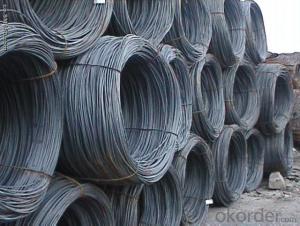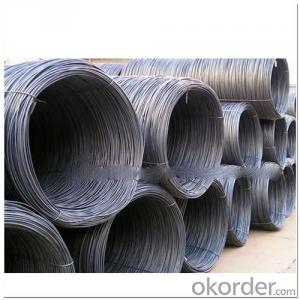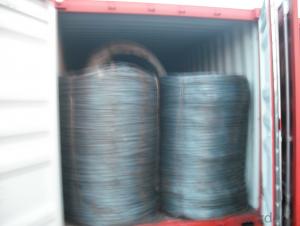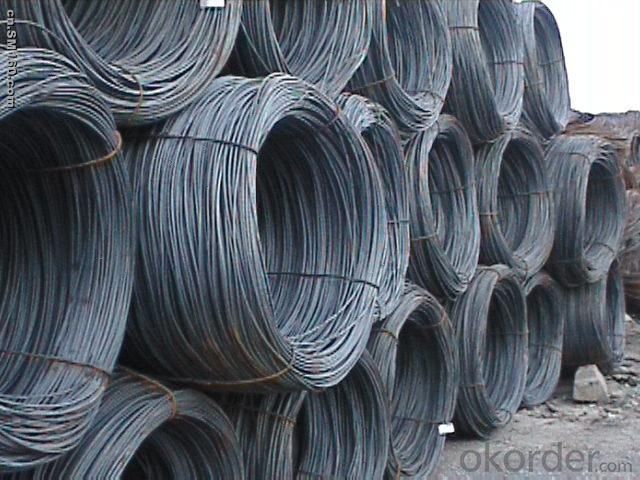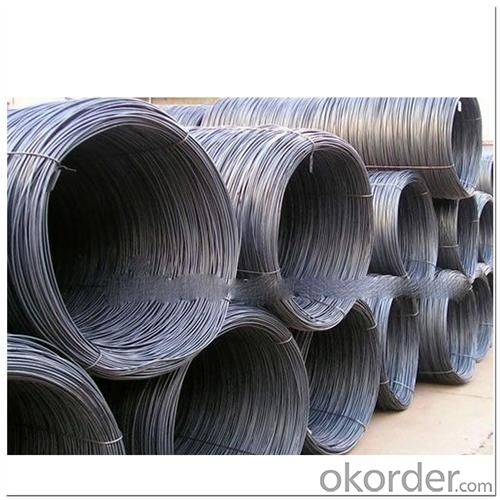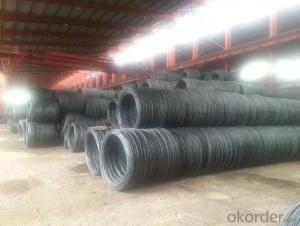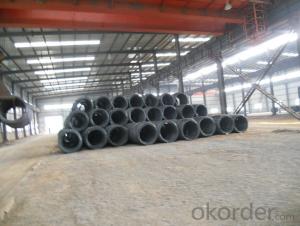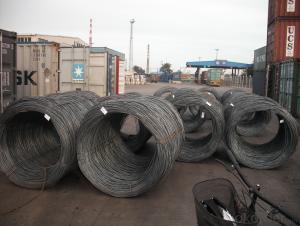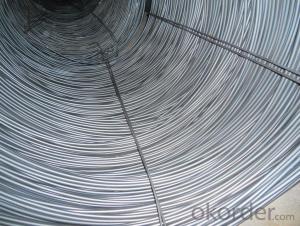Hot Rolled Carbon Steel Wire Rod in Coil
- Loading Port:
- China Main Port
- Payment Terms:
- TT or LC
- Min Order Qty:
- -
- Supply Capability:
- -
OKorder Service Pledge
OKorder Financial Service
You Might Also Like
Product Description:
OKorder is offering Wire Rod at great prices with worldwide shipping. Our supplier is a world-class manufacturer of steel, with our products utilized the world over. OKorder annually supplies products to European, North American and Asian markets. We provide quotations within 24 hours of receiving an inquiry and guarantee competitive prices.
Product Applications:
After hot-rolled the products shaped into coil and delivery as finished product, including round, square, rectangular, hexagonal and so on. Since most of the products are round, it is generally called wire rod. Carbon steel wire rod is widely used in construction and manufacturing. Carbon steel wire rod is mainly used for reinforcement of reinforced concrete and welded structure or reprocessed (roberts , nail, etc.) materials, especially used to produce wire drawing, welding electrode, nails, spring, electronic, precise machinery parts and so on.
.
Product Advantages:
OKorder's Wire Rod are durable, strong, and resist corrosion.
Main Product Features:
· Premium quality
· Prompt delivery & seaworthy packing (30 days after receiving deposit)
· Corrosion resistance
· Can be recycled and reused
· Mill test certification
· Professional Service
· Competitive pricing
Product Specifications:
Steel Grade: Q195/235, SAE1006-1018B Standard: ASTM, GB
Diameter: 5.5mm, 6.5mm, 7mm,8mm,9mm,10mm,12mm,14mm
Type: in coil, coil weight around 2MT Alloy or Not: Alloy
Surface: round, no twisted, light and smooth Chemical Composition: (Please kindly find our chemistry of our material based on Q195、Q235A and Q235B as below for your information)
Trademark | Rank | Chemical composition (quality score) % | |||||
C | Si | Mn | S | P | |||
| ≤ |
| ≤ | ≤ | |||
Q195 |
| 0.06-0.12 | 0.30 | 0.25 | 0.050 | 0.045 | |
Q235 | A | 0.14-0.22 | 0.30 | 0.30-0.65 | 0.050 | 0.045 | |
Q235 | B | 0.12-0.20 | 0.30 | 0.30-0.70 | 0.045 | 0.045 | |
Trademark | Rank | Pulling Test | |||||
Bend PointΔs/Mpa | Tensile Strength | Elongation Ratioδ5% | |||||
Thickness (Diameter) /MM | Thickness (Diameter) /MM | ||||||
≤16 | 16-40 | ≤16 | 16-40 | ||||
≥ | ≥ | ||||||
Q195 |
| 195 | 185 | 315-390 | 33 | 32 | |
Q235 | A | 235 | 225 | 375-500 | 26 | 25 | |
Q235 | B | 235 | 225 | 375-500 | 26 | 25 | |
Note:
1. Our products are produced according to national standard (GB), if not, supply according to national standards (GB) or agreement as customer required.
2. Other Grade and Standard carbon steel wire rod we can supply:
Grade: H08A, 30MnSi, 62B-82B
Standard: AISI, BS, JIS, DIN
The Minimum Order Quantity of these products is high, and need to be confirmed.
3. We can not only supply carbon steel wire rod; if you need anything about building materials, please contact us.
4. Please send us your detail specifications when inquire. We will reply to you as soon as possible. We sincerely hope we can establish a long stable business relationship.
FAQ:
Q1: Why buy Materials & Equipment from OKorder.com?
A1: All products offered byOKorder.com are carefully selected from China's most reliable manufacturing enterprises. Through its ISO certifications, OKorder.com adheres to the highest standards and a commitment to supply chain safety and customer satisfaction.
Q2: How do we guarantee the quality of our products?
A2: We have established an advanced quality management system which conducts strict quality tests at every step, from raw materials to the final product. At the same time, we provide extensive follow-up service assurances as required.
Q3: What makes stainless steel stainless?
A3: Stainless steel must contain at least 10.5 % chromium. It is this element that reacts with the oxygen in the air to form a complex chrome-oxide surface layer that is invisible but strong enough to prevent further oxygen from "staining" (rusting) the surface. Higher levels of chromium and the addition of other alloying elements such as nickel and molybdenum enhance this surface layer and improve the corrosion resistance of the stainless material.
Images:
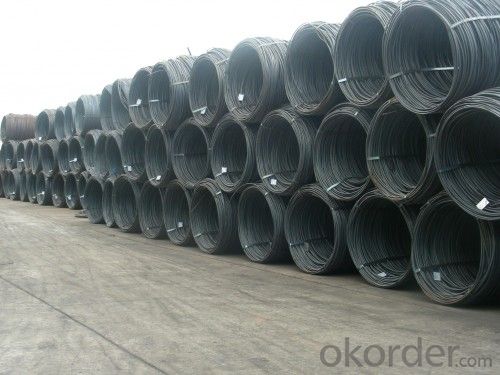
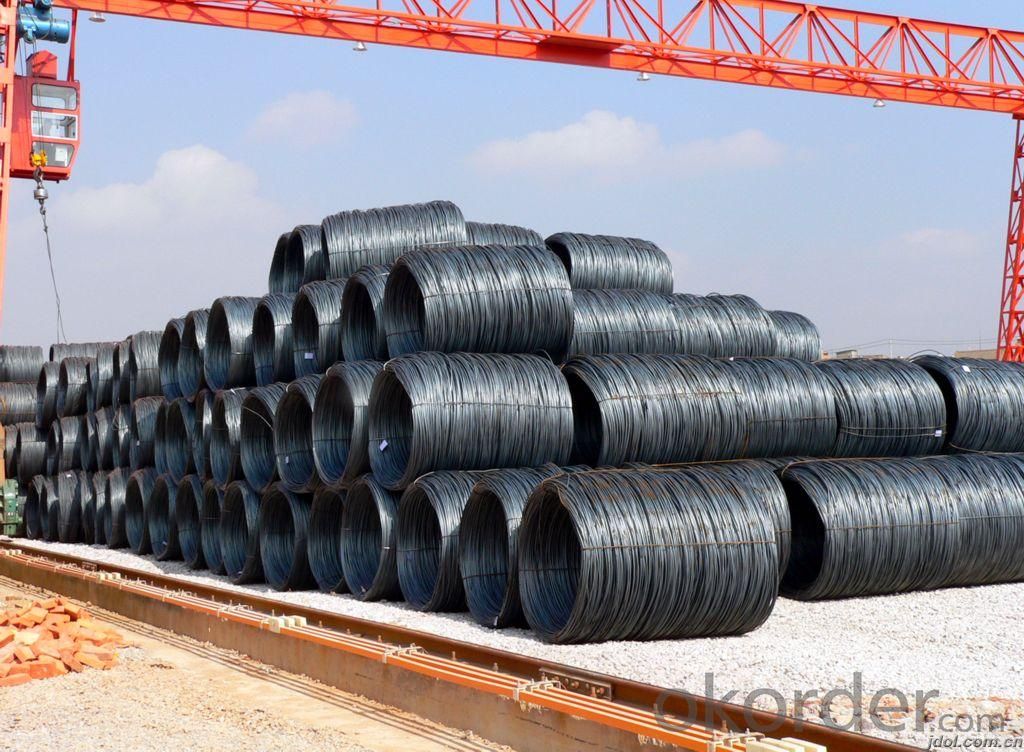
- Q: How is steel wire rod used in the manufacturing of wire cages?
- Steel wire rod is used in the manufacturing of wire cages as it serves as the primary raw material for constructing the cage structure. The steel wire rod is typically bent, shaped, and welded to create the framework of the wire cage, providing strength, durability, and stability to the overall structure. Additionally, steel wire rod can be further processed to form different gauges and coatings, allowing for customization based on the specific requirements of the wire cage application.
- Q: How does the yield strength of steel wire rod vary with different wire drawing processes?
- The yield strength of steel wire rod generally increases with different wire drawing processes. Wire drawing involves pulling the rod through a die to reduce its diameter and increase its length. This process aligns the metal grains and elongates them, resulting in a more uniform and stronger structure. The higher the reduction ratio (the ratio of the initial diameter to the final diameter), the greater the increase in yield strength. Additionally, the use of heat treatments during or after wire drawing can further enhance the yield strength of the steel wire rod.
- Q: What are the common production processes for einsteinium-coated steel wire rod?
- The common production processes for einsteinium-coated steel wire rod typically involve a combination of metallurgical techniques and surface coating methods. The steel wire rod undergoes initial processing steps such as casting, hot rolling, and drawing to achieve the desired dimensions and mechanical properties. Subsequently, the wire rod is subjected to a surface treatment process to apply the einsteinium coating. This coating can be achieved through various methods including physical vapor deposition (PVD), chemical vapor deposition (CVD), or electroplating. The specific production processes may vary based on the intended application and requirements of the einsteinium-coated steel wire rod.
- Q: How is the surface roughness of steel wire rod measured?
- The surface roughness of steel wire rod is commonly measured using a device called a profilometer. This instrument scans the surface of the wire rod and provides measurements of the roughness parameters such as Ra (average roughness), Rz (maximum peak-to-valley height), and Rt (total roughness). These measurements help determine the quality and suitability of the wire rod for various applications.
- Q: What are the standard surface roughness requirements for steel wire rod?
- The standard surface roughness requirements for steel wire rod vary depending on the specific application and industry standards. However, in general, steel wire rod is expected to have a smooth and uniform surface with minimal imperfections. For construction purposes, such as reinforcing concrete structures, the surface roughness requirements are relatively lenient. It is common for steel wire rod used in construction to have a surface roughness of Ra 3.2 to 6.3 micrometers (125 to 250 microinches). In contrast, for more demanding applications like precision engineering or automotive manufacturing, higher surface quality is required. In these cases, the surface roughness requirements for steel wire rod are typically stricter, with a range of Ra 0.8 to 1.6 micrometers (32 to 63 microinches). It is important to note that these values are not universal and can vary depending on specific industry standards or customer preferences. Manufacturers and suppliers of steel wire rod typically provide detailed specifications and standards that need to be met for specific applications, ensuring that the required surface roughness is achieved.
- Q: What are the different high-temperature properties of steel wire rod?
- Various applications can benefit from the suitability of steel wire rods due to their multiple high-temperature properties. Among these properties, high thermal stability stands out as a key feature. It enables the wire rods to maintain their structural integrity even when exposed to elevated temperatures. This characteristic is crucial in industries like automotive and aerospace, where parts made of steel wire rods endure high temperatures during operation. Another significant property of steel wire rods at high temperatures is their resistance to oxidation. To protect against corrosion, these wire rods are usually coated with a layer of zinc or galvanized coating. This protective layer acts as a barrier, preserving the wire rods' strength and preventing them from corroding when subjected to harsh environments and high temperatures. Furthermore, steel wire rods exhibit exceptional mechanical properties at elevated temperatures. They possess high tensile strength and good resistance to creep, allowing them to endure heavy loads and prolonged exposure to high temperatures without deforming or breaking. These characteristics make them an ideal choice for industries such as construction and manufacturing, where strength and durability are essential. Moreover, steel wire rods also exhibit good thermal conductivity, enabling efficient heat transfer. This property proves beneficial in applications like heating elements, where the wire rods are utilized to generate and distribute heat evenly. In conclusion, the various high-temperature properties of steel wire rods, including thermal stability, resistance to oxidation, excellent mechanical properties, and good thermal conductivity, make them a versatile and dependable material for numerous high-temperature applications across various industries.
- Q: How are steel wire rods used in the production of wire cables for transmitting signals?
- Steel wire rods are essential components in the production of wire cables used for transmitting signals. These rods are initially manufactured by hot rolling billets of low carbon steel into long, thin shapes. This process ensures that the steel wire rods have the necessary strength and flexibility required for their application in wire cable production. Once the steel wire rods are obtained, they undergo various steps to transform them into wire cables capable of transmitting signals. The first step involves cleaning and coating the rods to prevent corrosion and improve their durability. This coating can be made of zinc, copper, or other materials depending on the specific requirements of the cable. After the rods are coated, they are then drawn through a series of dies to decrease their diameter and increase their length. This drawing process further enhances the strength and flexibility of the rods, making them suitable for the demanding conditions that wire cables may encounter during installation and use. The drawn steel wire rods are then twisted or braided together to form the core of the wire cable. This core provides the necessary mechanical strength and stability for the cable, allowing it to withstand tension and external forces. The number of rods used in the core can vary depending on the desired strength and thickness of the cable. To ensure efficient signal transmission, the core is covered with an insulating material, typically made of plastic or rubber. This insulation protects the core from damage, prevents electrical interference, and maintains the integrity of the signal being transmitted. Finally, the completed wire cables are tested to ensure their quality and performance. They are inspected for any defects or imperfections that could affect their ability to transmit signals effectively. Once approved, these cables are ready to be used in various applications, such as telecommunications, electrical systems, and data transmission. In summary, steel wire rods play a crucial role in the production of wire cables used for transmitting signals. They provide the necessary strength, flexibility, and durability to withstand the demanding conditions that wire cables may encounter. Through a series of processes, these rods are transformed into wire cables capable of efficiently transmitting signals while maintaining their mechanical integrity.
- Q: How is steel wire rod used in the manufacturing of wire rope slings?
- Steel wire rod is used in the manufacturing of wire rope slings as it serves as the raw material for creating the wire strands that form the core and outer layers of the sling. The wire rod is first drawn and shaped into individual wires, which are then twisted and laid together to form the wire strands. These strands are then further twisted and braided around a core to create a strong and durable wire rope sling that can be used for lifting and hoisting heavy loads.
- Q: What are the main factors influencing the choice of steel wire rod payment terms?
- There are several main factors that can influence the choice of payment terms for steel wire rod. One of the primary factors is the financial stability and creditworthiness of the buyer. If the buyer has a strong financial position, the seller may be more willing to offer favorable payment terms, such as longer payment periods or installment payments. On the other hand, if the buyer has a poor credit history or financial instability, the seller may require stricter payment terms, such as upfront payment or shorter payment periods. The market conditions and competition can also impact the choice of payment terms. In a highly competitive market with multiple suppliers, the seller may need to offer more flexible payment terms to attract buyers. This could include options like deferred payment or payment upon delivery. Conversely, in a market with limited suppliers or high demand, the seller may have more leverage and can dictate stricter payment terms. The nature of the business relationship between the buyer and seller is another crucial factor. If the buyer and seller have a long-standing relationship with a history of successful transactions, the seller may be more willing to offer favorable payment terms as a gesture of trust and loyalty. Additionally, the volume and frequency of purchases can also influence the payment terms. Buyers who consistently purchase large quantities of steel wire rod may have more negotiating power and be able to secure more favorable payment terms. Lastly, external factors such as economic conditions, currency fluctuations, and government regulations can also impact the choice of payment terms. In times of economic uncertainty or currency volatility, sellers may be more cautious and require stricter payment terms to mitigate their risk. Similarly, government regulations related to international trade or finance can also affect the choice of payment terms. Overall, the main factors influencing the choice of payment terms for steel wire rod include the financial stability of the buyer, market conditions, the nature of the business relationship, and external factors such as economic conditions and government regulations.
- Q: How are steel wire rods used in the manufacturing of nails?
- Steel wire rods are a crucial component in the manufacturing of nails. These rods are typically made from high-quality steel, which is known for its strength and durability. The first step in the process involves the selection of the appropriate steel wire rod based on the desired nail specifications. The diameter and tensile strength of the rod are carefully chosen to ensure the final nail meets the required standards. Once the steel wire rods are selected, they are fed into a nail-making machine. This machine consists of various sections that work together to transform the wire rod into a nail. The first section of the machine straightens the wire rod, ensuring it is aligned correctly. The rod then moves to the cutting section, where it is cut into the desired length for the nail. Next, the rod enters the forming section, where it is shaped into the basic structure of the nail. This section uses a combination of mechanical force and heat to mold the wire rod. After the forming process, the nail is passed through a series of rollers and dies to refine its shape and enhance its strength. These rollers and dies give the nail its characteristic head, shank, and point. Finally, the nails are cooled and inspected for quality control. Any defective nails are discarded, and the acceptable ones are collected and packaged for distribution. Overall, steel wire rods are essential in the manufacturing of nails as they provide the raw material necessary for creating sturdy, reliable nails. The strength and durability of steel make it an ideal material for nails, allowing them to withstand the pressures and forces they will encounter during use.
Send your message to us
Hot Rolled Carbon Steel Wire Rod in Coil
- Loading Port:
- China Main Port
- Payment Terms:
- TT or LC
- Min Order Qty:
- -
- Supply Capability:
- -
OKorder Service Pledge
OKorder Financial Service
Similar products
Hot products
Hot Searches
Related keywords
